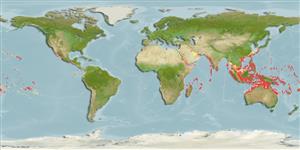>
Gobiiformes (Gobies) >
Gobiidae (Gobies) > Gobiinae
Etymology: Priolepis: Greek, prio = to saw + Greek,lepis = scale (Ref. 45335); cincta: Name from Latin cinctum, a girdle or belt, presumably referring to the banded color pattern; treated as a noun in apposition by Winterbotton & Burridge, 1993:2063 (Ref. 10753).
More on author: Regan.
Issue
Specific name to be examined, treated as a noun in apposition in Ref. 10753, but CofF treat the name as an adjective.
Environment: milieu / climate zone / depth range / distribution range
Ecologie
marien; brak water rifbewoner; standvastig; diepte 1 - 70 m (Ref. 2334), usually 1 - 30 m (Ref. 9002). Tropical; 32°N - 24°S
Indo-West Pacific: Red Sea, Persian Gulf and east coast of Africa to islands of Micronesia, Fiji and Tonga; Japan to Coral Sea.
Grootte / Gewicht / Leeftijd
Maturity: Lm ? range ? - ? cm
Max length : 7.0 cm FL mannelijk / geslacht onbekend; (Ref. 5525)
Korte beschrijving
Determinatiesleutels | Morfologie | Morfometrie
Dorsale stekels (totaal) : 7 - 8; Dorsale zachte stralen (totaal) : 11; Anale stekels: 1; Anale zachte stralen: 9. Characterized by having alternating dark-edged brown and narrower white bars on head and body; dorsal and caudal fins with brown spotting; basal part of dorsal fins with dark spots/bands; longitudinal scale series 27-31; ctenoid scales on body except cycloid on abdomen, prepectoral and prepelvic areas; upper opercle with a patch of cycloid scales; cheek without scales; depth of body 3.8-4.6 in SL (Ref. 90102).
Hides in caves and crevices (Ref. 9710), also among corals or rock (Ref. 37816). Monogamous (Ref. 52884).
Levenscyclus en paargedrag
Maturiteit | Voortplanting | Paaien | Eieren | Fecunditeit | Larven
Benthic spawner (Ref. 31409). Bi-directional sex change was proposed for this species (Ref. 103751). Monogamous mating is observed as both obligate and social (Ref. 52884).
Randall, J.E., G.R. Allen and R.C. Steene, 1990. Fishes of the Great Barrier Reef and Coral Sea. University of Hawaii Press, Honolulu, Hawaii. 506 p. (Ref. 2334)
Status op de Rode Lijst van het IUCN (Ref. 130435: Version 2024-1)
Gevaar voor de mens
Harmless
Gebruik door de mens
Visserij: commercieel; Aquarium: Commercieel
Tools
Speciale rapporten
Download XML
Internetbronnen
Estimates based on models
Preferred temperature (Ref.
123201): 24.8 - 29, mean 27.7 °C (based on 1094 cells).
Fylogenetische diversiteitsindex (Ref.
82804): PD
50 = 0.5000 [Uniqueness, from 0.5 = low to 2.0 = high].
Bayesian length-weight: a=0.00851 (0.00502 - 0.01443), b=3.04 (2.90 - 3.18), in cm total length, based on LWR estimates for this species & (Sub)family-body (Ref.
93245).
Trofisch niveau (Ref.
69278): 3.3 ±0.3 se; based on size and trophs of closest relatives
Weerstandsvermogen (Ref.
120179): Hoog, minimale populatieverdubbelingstijd minder dan 15 maanden (Preliminary K or Fecundity.).
Fishing Vulnerability (Ref.
59153): Low vulnerability (10 of 100).
Nutrients (Ref.
124155): Calcium = 141 [73, 310] mg/100g; Iron = 0.908 [0.442, 1.714] mg/100g; Protein = 18.6 [16.6, 20.2] %; Omega3 = 0.186 [0.081, 0.349] g/100g; Selenium = 24.8 [11.6, 64.8] μg/100g; VitaminA = 131 [35, 444] μg/100g; Zinc = 2.53 [1.67, 3.75] mg/100g (wet weight);
